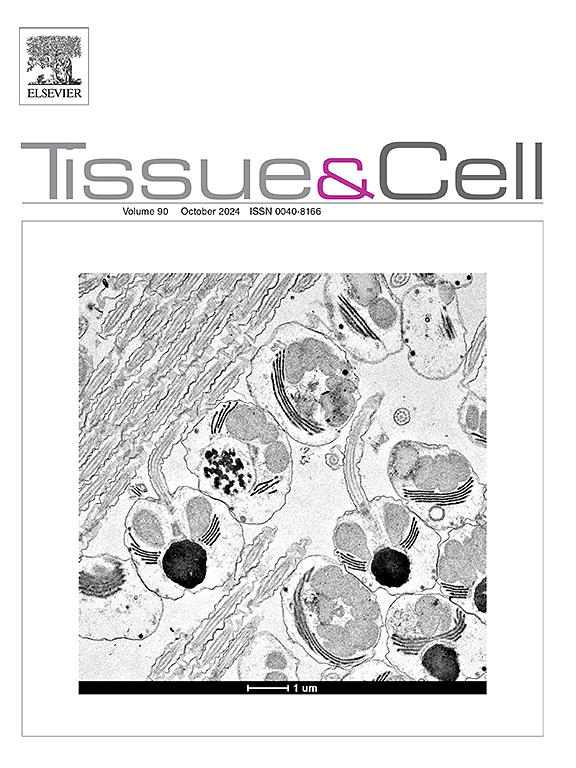Expression and biological activity of a novel protein species from cementum
IF 2.7
4区 生物学
Q1 ANATOMY & MORPHOLOGY
引用次数: 0
Abstract
Cementum is a specialized mineralized connective tissue with singular histological and functional characteristics. Proteins isolated from human cementum appear to regulate periodontal ligament stem cells differentiation, help to maintain homeostasis and appear to control some of the molecular events required for periodontium formation, therefore emerging as novel therapeutic candidates for periodontal regeneration. The possibility that there might be cementum components, so far not described, was explored in these studies. This study reports the expression and biological activity of a novel human species from cementum termed cementogenin (CMGN). This molecule encodes a 195 aminoacid protein species with a predicted molecular mass of 20.2 kDa. Polyclonal antibodies against a GMGN’s selected peptide sequence were produced to identify the protein. Expression of CMGN in cells of the periodontium was examined by Western blot and immunofluorescence using histological sections of the periodontium. These studies revealed that CMGN is expressed by cementoblasts and cells of the periodontal ligament. Expression of CMGN’s mRNA and its protein in different periodontium cell types was determined by RT-qPCR and Western blot, respectively. CMGN mRNA and gene product levels were highly expressed by cementoblasts and osteoblasts cells. The CMGN protein was expressed in E. coli for functional studies using in vitro cell-free system. Assays revealed that hrCMGN promotes the nucleation of hydroxyapatite crystals. The human recombinant CMGN (hrCMGN) promoted cell proliferation, cell attachment, and differentiation by human periodontal ligament cells to a mineralized phenotype. Overall, our findings reveal that CMGN represents a new species isolated from cementum and might provide the basis for future studies that will allow further characterization of the structural features of CMGN and a better understanding of its functional properties. This new protein might be highly relevant in future periodontal therapeutics.
一种新的骨水泥蛋白的表达及生物活性研究
骨质是一种特殊的矿化结缔组织,具有独特的组织学和功能特征。从人牙骨质中分离的蛋白质似乎可以调节牙周韧带干细胞的分化,帮助维持体内平衡,并似乎控制牙周组织形成所需的一些分子事件,因此成为牙周再生的新治疗候选物。这些研究探讨了可能存在骨质成分的可能性,迄今为止尚未描述。本研究报道了一种新的人类牙骨质物种cementogenin (CMGN)的表达和生物活性。该分子编码195个氨基酸的蛋白质物种,预测分子质量为20.2 kDa。制备了针对GMGN选定肽序列的多克隆抗体来鉴定该蛋白。采用Western blot和免疫荧光法对牙周组织切片检测CMGN在牙周组织细胞中的表达。这些研究表明CMGN在牙周韧带的成骨水泥细胞和细胞中表达。RT-qPCR和Western blot分别检测CMGN mRNA和蛋白在不同牙周细胞类型中的表达。成水泥细胞和成骨细胞高度表达CMGN mRNA和基因产物水平。在大肠杆菌中表达CMGN蛋白,利用体外无细胞系统进行功能研究。实验表明hrCMGN促进羟基磷灰石晶体成核。人重组CMGN (hrCMGN)促进人牙周韧带细胞增殖、细胞附着和分化至矿化表型。总之,我们的发现表明CMGN代表了一个从牙骨质中分离出来的新物种,并可能为未来的研究提供基础,从而进一步表征CMGN的结构特征并更好地了解其功能特性。这种新蛋白可能与未来的牙周治疗高度相关。
本文章由计算机程序翻译,如有差异,请以英文原文为准。
求助全文
约1分钟内获得全文
求助全文
来源期刊

Tissue & cell
医学-解剖学与形态学
CiteScore
3.90
自引率
0.00%
发文量
234
期刊介绍:
Tissue and Cell is devoted to original research on the organization of cells, subcellular and extracellular components at all levels, including the grouping and interrelations of cells in tissues and organs. The journal encourages submission of ultrastructural studies that provide novel insights into structure, function and physiology of cells and tissues, in health and disease. Bioengineering and stem cells studies focused on the description of morphological and/or histological data are also welcomed.
Studies investigating the effect of compounds and/or substances on structure of cells and tissues are generally outside the scope of this journal. For consideration, studies should contain a clear rationale on the use of (a) given substance(s), have a compelling morphological and structural focus and present novel incremental findings from previous literature.
 求助内容:
求助内容: 应助结果提醒方式:
应助结果提醒方式:


